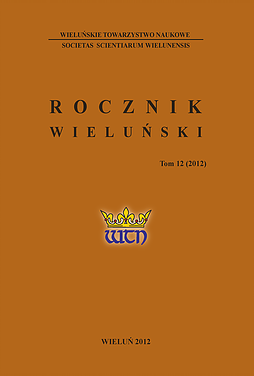Artyleria w działaniach zbrojnych pod Wieluniem i Bolesławcem nad Prosną w latach 1391–1396
Artillery in armed hostilities in Wielun and Boleslawiec on the Prosna in 1391–1396
Author(s): Piotr StrzyżSubject(s): Military history, 13th to 14th Centuries, Peace and Conflict Studies
Published by: Wieluńskie Towarzystwo Naukowe
Summary/Abstract: In the years 1391–1396an armed conflict broke out between Władysław Jagiełło, King of Poland and Władysław Duke of Opole. The Duke’s dominions which were crucial for the territorial integrity of the Kingdom of Poland were the object of the conflict. The area involved included the north-west part of the Cracow Land, a part of the Sieradz Land, which means that it formed a link between Małopolska (Little Poland) and Wielkopolska (Great Poland) (Fig. 1). Stone balls, found in Wieluń and Bolesławiec, 16, 26, 29, 31 and 49 cm in diameter (Fig. 2), for 4–5 bombards are the relics of those military actions. The reference material collected on the Western Europe territory in the form of several preserved bombard barrels of largest diameters (Fig. 4) enables historians, in turn, to determine the technical specifications of the heaviest Polish artillery of that time. In the light of analysis performed, the barrel of such a cannon, with the diameter of circa 50 cm should be circa 3–4 m long and weigh from 2 to 4 tonnes, and, in turn, the lower caliber cannons of 26–29 cm in diameter had barrels 2 m lon and weighed 1.5–2 tonnes. The historical records evidence that at least 1500 grzywnas were allocated for the purchase and operation of the guns during the whole campaign. We do not have at our disposal any descriptions of damage inflicted by the heavy canons used by Poles. Consequently, we cannot asses what its influence on the military operation was. One may only assume that due to low rate of fire and poor accuracy of then cannons their impact was very limited.
Journal: Rocznik Wieluński
- Issue Year: 12/2012
- Issue No: 12
- Page Range: 89-106
- Page Count: 18
- Language: Polish

